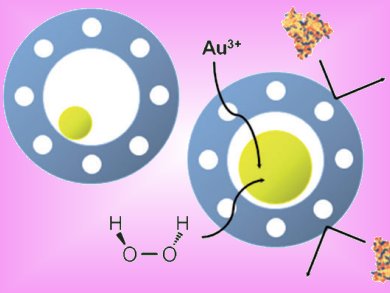Localized surface plasmon oscillations give rise to the intense colors of suspensions or sols containing nanoparticles (NPs). Shifts in this resonance due to changes in the local index of refraction upon adsorption to the NPs can be used to detect biopolymers such as DNA or proteins. This has led to surface plasmon resonance (SPR) being the basis for biosensor applications and lab-on-a-chip sensors. Most detection applications using SPR were verified in well-purified analyte solutions, and the sensing of target analytes in more natural and unprocessed samples, such as serum or plasma, remains a challenge.
In Su Lee and co-workers, Kyung Hee University, Korea, developed a hollow silica nanoshell carrying a Au NP inside the cavity. This acts as a seed, becoming enlarged as a gold precursor complex in the solution attaches to its surface and is reduced by the analyte. Growth of the seed gave a SPR shift that could be used to determine the analyte concentration. The porous silica shell only allowed penetration of small analytes, blocking access of bulky biomolecules.
This enabled the selective and sensitive sensing of hydrogen peroxide and glucose, even in samples containing interfering biomolecules.
Image: © Wiley-VCH
- Seed-mediated Growth of Gold inside Hollow Silica Nanospheres for Sensing Peroxide and Glucose Concentrations
T.-L. Ha, J. Shin, C. W. Lim, I. S. Lee,
Chem. Asian J. 2011.
DOI: 10.1002/asia.201100501




